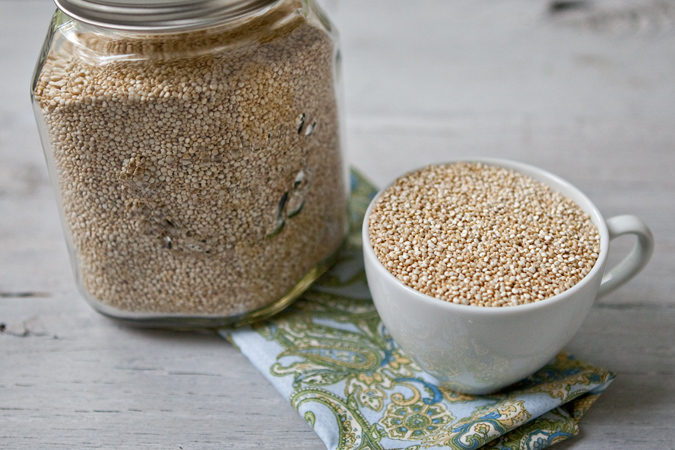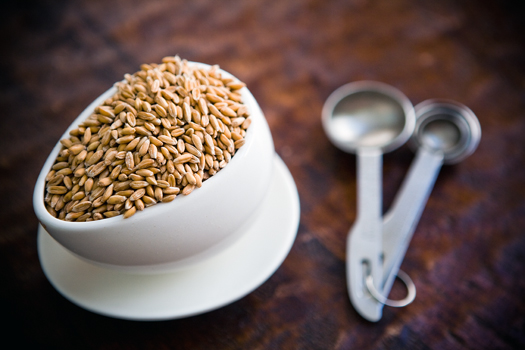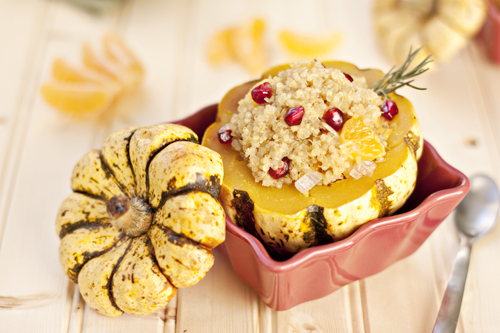This month in the Eat Well, Spend Less series we’re talking about whole grains from storage to recipes. It’s emergency preparedness month, and I’m dissecting how having whole grains on hand can help you be fed and nourished in that situation.

I’m going to go out on a limb and am going to assume that when the majority of people think about whole grains their minds instantly wander to bread products, cereals and whole wheat pastas first before anything else. I suppose that it has a lot to do with modern advertising, the touting claims of the benefits of whole grains on brightly-colored boxes of cereal and heart healthy labels affixed to encourage you to buy them.
This post, however, is not about cereal and bread. Instead, this post is about whole grains, the seeds of grasses or pseudocereal seeds, cultivated and used for food.
Seeds of grasses. Yep. I’m all about eating grass seed, especially if it looks like popcorn, brown rice, oats and spelt. On the pseudocereal side you have broadleaf seeds like quinoa and amaranth that behave in a similar way to cereal grains.

What are Whole Grains?
Whole grains are made up of three parts: germ, endosperm and bran. The germ is the smallest part, a small nutrient-packed core of the seed. The endosperm is that fluff filling that whole grains have, and it is also what refined grains like all-purpose flour are made out of. Finally, the bran is the outer layer that serves to protect the seed, which is also high in nutrients, vitamins and just pleasant goodness.

Now that I’ve bored you with the facts, let’s talk about the food part of whole grains. Grains are great to have around in case of emergency situations where access to a store may not be possible (snowmaggedon-style). It goes without saying that grains can also be soaked and cooked with the use of a camp stove, fire pit and with the help of a generator in the case of a power outage.
Whole Grain Storage
Whole grains don’t store as long as their refined counterparts, but if you’re careful about how and where you store them, you can successfully keep most fresh for 6 months to a year.
Store whole grains in clean, sealed glass jars in cool, dark locations. Some grains store well in the refrigerator or freezer, but generally speaking, a cool pantry location will suffice. Most grains can be kept for up to a year if properly stored, but some like buckwheat and millet will not last as long in a pantry. Refer to this rather comprehensive list for storage of whole grains for proper storage techniques and length.

Cooking with Whole Grains
Generally, grains are cooked by covering with water, brought to a boil and then simmered until the water is absorbed, much like you would cook rice. Different grains can need anywhere from 12 to 60 minutes to cook, and that may also include overnight presoaking. However, you can also grind grain into flour and sprout grain prior to cooking with it.
Whole Grain Recipes
::Cream of Turkey and Wild Rice Soup | Food for My Family
::Quinoa, Clementine and Pomegranate Stuffed Sweet Dumpling Squash | Food Your Way
::Vegetable Fried Rice | Food for My Family
::Steel-Cut Oats with Caramelized Onions and Ricotta | In Jennie’s Kitchen
::5-Grain Pancakes with Flax | goodLife {eats}
::Whole Grain Sourdough Bread | Simple Bites
::Amaranth, Quinoa Dark Chocolate Cake | La Tartine Gourmande
::Kamut Sand Cookies | Deliciously Organic
::Spelt Almond Plum Coffee Cake | Cheeky Kitchen
::Spelt Everything Crackers | Smitten Kitchen
As always, you can check out what others are writing in the Eat Well, Spend Less series and how they stay prepared for emergencies, including storing lentils, beans, freezer meals and more:
- Aimee from Simple Bites
- Alyssa from Kingdom First Mom
- Carrie from Denver Bargains
- Jessica from LifeasMOM
- Katie from Good Life Eats
- Katie from Kitchen Stewardship
- Mandi from Life Your Way
- Tammy from Tammy’s Recipes






This is a great post, Shaina! We eat a lot of whole grains in our house, particularly quinoa and brown rice. I’m looking forward to seeing more of this series.
I love a lot of these grains. I have to eat them judiciously now, as they are still high carb for me, but I love quinoa and barley and oatmeal. Great post.
I always have oats, rice and other grains on hand. They really are an essential pantry item.
We love whole grains! Quinoa is a family fav!
I love it when you talk about eating grass! 😉
Awesome post. Welcome home!
Guilty as charged. I am totally one of those people who’s mind immediately wanders to baked goods. I need to be better about using whole grains in recipes besides baking. I have a couscous stuffed pepper recipe I really like and a couple other of those type of grain recipes but I often forget about them. Thanks for the reminder!
You are so smart. I just thought whole grains were like wheat and stuff. 😉
Ha. I like you.
Nice informative post! I’ve been introducing my family to whole grains over the years, including brown rice, kasha, quinoa, amaranth and millet. I also bake with whole grain flours, including gluten-free whole grain flours.
what a great post on whole grains! My company is really big on them and we serve a whole grain at each meal.
thanks for some new ideas!
awesome info and post! Fabulous!
Lots of great info Shaina!
Just bought some quinoa from nutsonline.com. And lemon chips too to put in my whole grain cocoa cookies! Happy Fall! http://bestorganizingtips.blogspot.com/2011/09/anyone-can-bake-this-muffin.html
Great post. I taught a class on whole grains and cooked various recipes using heirloom grains. It was so involved yet of a group of 30+ people hardly a single one knew 1/2 of what I shared with them. Quite frankly I even learned a few things. Grains are quite involved but something we should all take the time to learn about.
Lots of great information here…I wasn’t bored with the facts; I found them very interesting, so thank you for sharing! 🙂